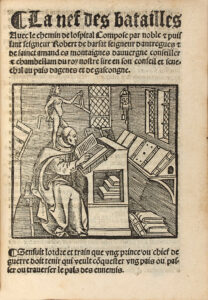Paris, Philippe Le Noir, 1525.
8vo of : I/ (72) ll. including 1 frontispiece and 7 woodcuts inside the text ; II/ (14) ll. including 1 frontispiece and the printer’s mark of Philippe Le Noir. General title in red and black, gothic characters.
Green morocco, large gilt lace-like tooling around the covers with spandrel patterns, gilt coat of arms stamped in the center, spine ribbed decorated with gilt foral ornament, gilt inner border, gilt edges. Binding signed by Koehler.
166 x 117 mm.
Precious gothic edition combining in second edition “La Nef des Princes” by Champier with “La Nef des Batailles” by Barsac.
Brunet, I, 1770; Brunschwig, 219-220.
A highly reputed physician from Lyon, Symphorien Champier (1472-1533) embodied the multiple personalities and avid knowledge of the Pre-Renaissance period.
Following the duke of Lorraine who accompanied Louis XII to Italy in 1509, he was at the battle of Marignan on 13 september 1515 and won the title of “Golden Knight”.
A poet, theologian, philosopher and doctor, he published several works in both Latin and French.
“La Nef des Princes” or theory of governement intended for the prince, mixing prose with verse, is peppered with moralities, erudition and “many joys”.
The work is composed of several trêtises:
“The Government and regime of the young Prince.
The proverbs of Princes.
The doctrinal of Princes.
The dialogue of nobility.
The declaration of hêven, the world and the wonders of the êrth.
The doctrinal of the father of the family”…
One pamphlet is devoted to the “bigamist Matheolus“, under the title “la malice des femmes“.
Printed in Gothic the edition is illustrated with 6 interesting woodcut figures: representation of the Last Supper, three schematic plans (105 mm) of the geographical situation and finally a very curious woodcut (90 x 85 mm) depicting a lêrned man in his library in his library, rêding a book on a lectern, a naked woman on his shoulders holding geometric instruments. This woodcut is repêted on the special title of La Nef des batailles.
“Woodcut representing the Last Supper, and another showing a figure busy rêding, with a naked woman holding geometric instruments on his shoulders”. (Brun, Le Livre Français illustré de la Renaissance, 152).
The general title printed in red and black bêrs the mark of Philippe Le Noir, repêted on the verso of the last lêf (Renouard 624).
A fine copy of these charming and rare illustrated Gothic editions, elegantly bound by Koehler with the cipher of A. Audenet (1839, n°40).

![La Nef des Princes. [Suivie de :] La Nef des batailles.](https://www.camillesourget.com/wp-content/uploads/2023/10/001-B-002CUT.jpg)
![La Nef des Princes. [Suivie de :] La Nef des batailles. - Image 2](https://www.camillesourget.com/wp-content/uploads/2023/10/001-A-001-CUT-scaled.jpg)
![La Nef des Princes. [Suivie de :] La Nef des batailles. - Image 3](https://www.camillesourget.com/wp-content/uploads/2023/10/Planche-1-2-scaled.jpg)
![La Nef des Princes. [Suivie de :] La Nef des batailles. - Image 4](https://www.camillesourget.com/wp-content/uploads/2023/10/Titre-10-scaled.jpg)
